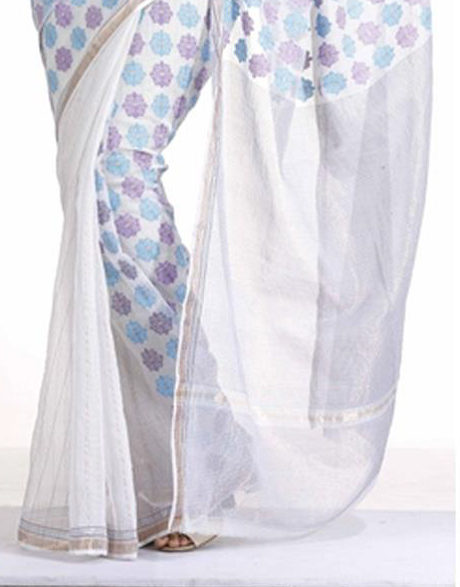Kota Doria Saree
Back ground
Doria (stripe) fabrics in narrow width for turban used to be woven in Kota in earlier days. Some weaver were brought from Mysore to Kota by the great patron of craft MahaRaj Kishore Singh (1684-1695). These weavers introduced silk yarn in Doria weaving in Kota and surrounding areas about 250 year ago. Today this activity is practised by the weavers of Hadoti region (Bundi, Kota and Baran districts of Rajasthan). Kota is now famous for ‘Kota Doria saree’ or sometimes called as ‘Kota Masuria saree’. Since then, Kota doria has under gone a long journey from being used as a pagri or turban (headgear) to saree and now has multiple uses like Dress material, stole, curtain & other products.

Material Used
Kota Doria Saree is produced by using cotton & mulberry raw silk yarns in the base fabric whereas Gold and Silver Zari (fine metal threads) yarns in extra warp and extra weft for designing. The cotton yarn provides strength and suppleness whereas fine raw silk makes the fabric transparent and delicate.
Technique applied
Kota doria saree is woven on a traditional throw shuttle pit loom in such a fashion that it creates small square check pattern in the fabric, locally called as Khat by putting the cotton and silk yarns in different densities both in the warp and weft directions. In a good quality Kota doria saree, there are about 300 to 350 ‘Khat’ across the width of the fabric. Design is developed by jala/ jacquard system. Pure zari is used in border and buti woven on extra weft designing technique.
How to distinguish genuine kotadoria saree
- Basic texture of saree is in combination of cotton and silk yarn. Cotton yarn gives stripe effect and silk yarn gives transparent effect on the fabric.
- One small check has 4 micro checks within creating an illusion in the fabric which is the special characteristic of Kota Doria Saree.
- Design does not appear very prominently on the sari because of checks formed in the ground texture of the fabric
- It is a light weight open textured fabric and soft to touch.
Source : India Handloom Brand
Last Modified : 9/5/2023
The objective of financial inclusion of women and ...
This topic provides information about Arni Silk Sa...
The objective of financial inclusion of women and ...
This topic provides information about Tweed.
